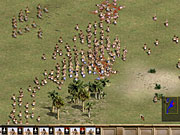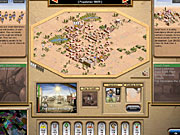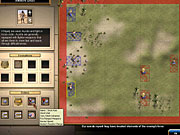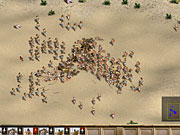Chariots of War is essentially a revision of Legion. The new turn-based strategy game from Slitherine Software and Paradox Entertainment updates last year's disappointing ancient-Rome strategy game with new civilizations and more-satisfying empire-building options. The end result is something of a poor man's Civilization, except with a simplistic and problematic combat engine, a lack of real depth, and an absence of multiplayer options.

At least Slitherine and Paradox have beefed up the Legion engine in every respect. Where Legion was a cut-rate look at the Roman Empire, with little in the way of strategy beyond setting up army formations and gathering the resources needed to build soldiers, its successor has a broader scope. Virtually every civilization from the ancient Near East is included for your conquering pleasure. The game has 10 playable nations, from the famed Egyptians and Babylonians to lesser-known entities like the Scythians and Hittites, along with another 50 or so less-prominent factions such as the Israelis and Bedouin.
The game is structured similarly to Paradox's award-winning Europa Universalis series, in that you can choose to guide any civilization on the map, although some are so weak in comparison with their neighbors that they're not very compelling unless you're really, really looking for a challenge. More than 200 authentic cities and settlements in historically accurate provinces can be plundered in the six solo campaigns. You can fight to unite Egypt, wage war over the Levant, conquer the cradle of civilization in Mesopotamia, direct the Hittites to mastery in Anatolia, or go after the whole region in the two grand campaigns.
So Chariots of War does have some pretty impressive breadth, but unfortunately, it doesn't have nearly as much depth. While Slitherine and Paradox may have spread out the game design, encompassing a lot of themes and gameplay mechanics embraced by large-scale strategy games like Civilization and Europa Universalis, Chariots of War is a pretty superficial game, and it has some serious flaws. For instance, everything is focused on combat. Building an empire is wholly dependent on conquering your neighbors, to the point where you can't establish new settlements or colonies. If you want a new town, you have to use troops to take an existing one.

That wouldn't be an issue if the battle engine weren't so unsatisfying. As in Legion, you don't take a hands-on approach to battles. Instead, you set up formations, plan out how units will attack and when, and then watch helplessly and hope you're victorious. The game has other options with regard to attack plans and specific formations when dealing with chariots, but being unable to make changes in the midst of a rout is as frustrating as ever, especially since you always lose your entire army in the event of a defeat. The game's artificial intelligence adds to this frustration, since it always seems to know the location of your weak points and will hone in on them unerringly. This makes the campaigns rather challenging, at least, and turns planning into more of an ongoing concern, since you can't just build dozens of units and steamroll enemy towns. But it's a shame that the game apparently has to bend the rules with inhumanly precise AI enemies to offer up this challenge.
Building an army in Chariots of War isn't all that interesting either, at least after you've done it once or twice. The unit types aren't diverse enough to represent the dozens of civilizations featured in the game. Some are restricted--such as the Medjay skirmishers and the Sea Peoples warband--but even these "unique" units are confined only to specific groups of nations. The Medjays are available to all the Nubian affiliations, the Sea Peoples are open to all tribal groups, and so on. There isn't nearly as much variety as you might hope for, especially since the game is billed as an epic clash between dozens of ancient civilizations.

Combat isn't everything in Chariots of War, although you might be able to call it the only thing. While resource collection is necessary, at least five of the nine different resource types are directly related to the production of military units, and all nine are gathered automatically as soon as you build the appropriate structures--though at least the resource model takes geography into account. For instance, wood and horses are both scarce and highly valuable resources in the game, as they were in the Near East at the time.
All resources are uncommon enough that trade and diplomacy are essential. This also nicely captures historical reality, as goods were traded all across the Near East in antiquity, and diplomatic relations were crucial to keeping people supplied with food and frankincense. But the game's trade and diplomatic interfaces are both inadequate. Neither feature is covered in the tutorial--though the tutorial itself isn't really helpful anyway--which suggests that these interfaces were tossed in at the last minute. Trade is essentially a spreadsheet that accounts for purchases and sales. Diplomacy involves sending an ambassador to a neighboring state, whereupon you gain some useless information about its attitude toward you and learn the identity of its worst enemy. Since your relationship with foreign powers is all about military capability and posture, it's hard to see the point of bothering with diplomacy at all, outside of standard trading.

Finally, the production values are low in Chariots of War. The game's dated 2D graphics make city development a lifeless chore, and the battlefield graphics feature choppy animations that make your troops look they're goose-stepping, Highland dancing, or performing some strange combination of the two. The game's sound is sparse, consisting mainly of foreign-sounding grunts from armies and generic music that sounds like something from a late-night movie with togas and Steve Reeves. And there is no multiplayer support whatsoever, online or off. You're stuck with the solo campaigns.
Add all this up and you have a game that improves upon Legion with more breadth, but still has a number of problems. Chariots of War may be an improvement on Legion, and it may focus on an often-neglected part of history in the early Near East civilizations, but there are better options out there if you enjoy historical strategy games like these.